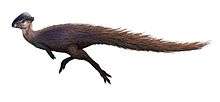Kosmoceratops
| Kosmoceratops Temporal range: Late Cretaceous, 76.4–75.9 Ma | |
|---|---|
 | |
| Holotype skull | |
| Scientific classification | |
| Kingdom: | Animalia |
| Phylum: | Chordata |
| Class: | Reptilia |
| Clade: | Dinosauria |
| Order: | †Ornithischia |
| Family: | †Ceratopsidae |
| Subfamily: | †Chasmosaurinae |
| Genus: | †Kosmoceratops Sampson et al., 2010 |
| Species: | †K. richardsoni |
| Binomial name | |
| Kosmoceratops richardsoni Sampson et al., 2010 | |
Kosmoceratops (from Ancient Greek κόσμος (kosmos "ornament, decoration"), κέρας (keras, "horn") and ὤψ (ōps, "face")) is a genus of herbivorous chasmosaurine ceratopsian dinosaur, which lived during the Late Cretaceous period (late Campanian) in the part of the island continent Laramidia that is now Utah, United States. Its fossils have been recovered from the Kaiparowits Formation in the Grand Staircase-Escalante National Monument.[1] It was first named by Scott D. Sampson, Mark A. Loewen, Andrew A. Farke, Eric M. Roberts, Catherine A. Forster, Joshua A. Smith, and Alan L. Titus in 2010 along with the chasmosaurine genera Utahceratops (also from the monument) and Vagaceratops (from Alberta).[1] The type species is K. richardsoni, named in honor of Scott Richardson, a volunteer who discovered the holotype specimen and many other fossils within the Grand Staircase-Escalante National Monument.[2]
Description

Kosmoceratops is distinguished by an ornate skull, the most ornate of any known dinosaur. The horns above the eyes are long, thin, and pointed. They project laterally from the skull and curve downward. The orientation of these horns differs from most other ceratopsians, in which the horns are oriented either forward, or backward. There is a forehead-like hump on the skull roof in front of the eye sockets. The nasal horncore, the bony projection from which the nose horn grew, is flattened and blade-like. The frill of Kosmoceratops is the shortest relative to its width of any ceratopsian; it is about twice as wide as it is long. The parietal fenestrae, two holes in the frill, are also very small and are positioned toward the back. The size of the frill and its fenestrae differ considerably from other chasmosaurines, many of which are known for their elongate frills. Ten hook-like projections rim the frill. Eight of these hooks curve forward to overlie the frill, while the other two are positioned on either side of it, curving laterally rather than rostrally. Overall, there are fifteen horns or horn-like structures on the skull, the most of any ceratopsian.[1]

Phylogeny

Below is a cladogram from Sampson et al. (2010):[1]
| |
| |||||||||||||||||||||||||||||||||||||||||||||||||||||||||||||||||||||||||||||||||||||||||||||||||||||||||
| |
Paleobiology

Kosmoceratops, along with most other chasmosaurines, inhabited Laramidia, an island continent at the time that now forms western North America. During the Late Cretaceous, Laramidia was separated from Appalachia, the eastern North American landmass, by the Western Interior Seaway. A major evolutionary radiation took place on Laramidia, with many major dinosaur clades known from across the island continent. Two endemic faunas may have existed in separate biomes or "provinces": one to the south of what is now Utah and Colorado, and one north of this region. Kosmoceratops, along with most other Campanian chasmosaurines, lived in the southern province, while the north was only inhabited by species of Chasmosaurus that existed in what is now Alberta.[1]
Chasmosaurines appear to have originated in Laramidia around 80-90 Ma, and dispersed throughout the continent by 77 Ma. By this time, a barrier had appeared in the area of Utah and Colorado that separated the two provinces. Kosmoceratops appeared in the southern province after the barrier appeared. Then, with the dissolution of the barrier around 75.7 Ma, the Kosmoceratops lineage migrated northward. In the northern province, forms such as Vagaceratops appeared. These forms would later give rise to the more derived chasmosaurines of the late Campanian and Maastrichtian stages, including Anchiceratops, Arrhinoceratops, and Triceratops.[1]
See also
References
- 1 2 3 4 5 6 Scott D. Sampson, Mark A. Loewen, Andrew A. Farke, Eric M. Roberts, Catherine A. Forster, Joshua A. Smith, Alan L. Titus (2010). Stepanova, Anna, ed. "New Horned Dinosaurs from Utah Provide Evidence for Intracontinental Dinosaur Endemism". PLoS ONE. 5 (9): e12292. doi:10.1371/journal.pone.0012292. PMC 2929175
 . PMID 20877459.
. PMID 20877459. - ↑ "Amazing Horned Dinosaurs Unearthed on 'Lost Continent'; New Discoveries Include Bizarre Beast With 15 Horns". ScienceDaily. 22 September 2010. Retrieved 22 September 2010.
| Wikimedia Commons has media related to Kosmoceratops. |


